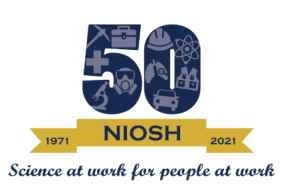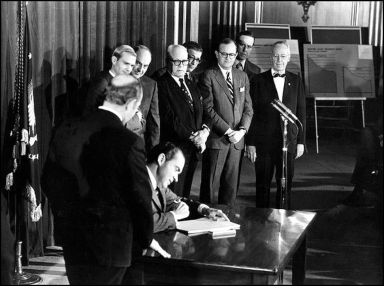Protecting America’s Workers: NIOSH Turns 50

For 50 years CDC’s National Institute for Occupational Safety and Health (NIOSH) has conducted research and made recommendations to prevent work-related injury and illness.
In December 1970 President Nixon signed the Occupational Safety and Health (OSH) Act into law. This started the process of establishing NIOSH, which officially opened its doors on April 28, 1971. Congress established NIOSH to create objective scientific research findings in the field of occupational safety and health with the mandate to assure “every man and woman in the Nation safe and healthful working conditions and to preserve our human resources.”
The Early Years
Early on, much of NIOSH’s research was devoted to coal mining, including responsibility for health hazard evaluations in mines and management of the Coal Workers’ Health Surveillance Program. By 1973 NIOSH had published the first seven Criteria Documents, which provided the basis for comprehensive occupational safety and health standards. The first Criteria Document was for asbestos. Since its publication, NIOSH has published or revised 150 Criteria Documents. Also, within the first decade, NIOSH established the first nine Education and Research Centers nationwide to prepare the future occupational safety and health workforce.
The 1980s saw the establishment of programs to address the health risks associated with workplace pesticide and lead exposure as well as the publication of a landmark study showing hazards of exposure to asbestos-contaminated vermiculite and lung cancer mortality in Libby, Montana.

President Nixon signs the Occupational Safety and Health (OSH) Act into law in December 1970, which started the process to establish NIOSH.
The 1990s brought about the establishment of the Centers for Agricultural Health and Safety and the National Occupational Research Agenda (NORA), a partnership program to stimulate innovative research and improved workplace practices.
Growing Responsibilities
Throughout the past five decades, NIOSH has expanded its work to include emerging safety and health concerns addressing both well-known and newly emerging hazards such as advanced manufacturing and robotics. NIOSH’s responsibilities have grown to supporting atomic weapons industry workers with cancer who filed claims for compensation under the Energy Employees Occupational Illness Compensation Program Act of 2000, as well as responders and survivors of the September 11, 2001, terrorist attacks in New York City, at the Pentagon, and near Shanksville, Pennsylvania.
Looking to the Future
Upon its creation, NIOSH had 475 employees. Today NIOSH has nearly 2,000 researchers, support staff and contractors in eight locations including: Anchorage, Alaska; Denver, Colorado; Washington, DC; Atlanta, Georgia; Cincinnati, Ohio; Pittsburgh, Pennsylvania; Spokane, Washington; and Morgantown, West Virginia. In addition, NIOSH has eight “virtual centers” through which researchers at its geographically dispersed locations work together to achieve NIOSH’s vision of safer, healthier workers.
Today, NIOSH is committed to continuing to grow and adapt to the rapidly changing nature of workplace and work issues experienced by today and tomorrow’s workforce.
